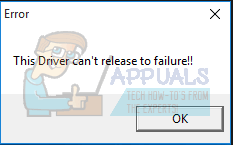2 Basic Solutions of ‘The driver can’t release to failure’ Error
The driver can’t release to failure is an error message that happens with users of Gigabyte motherboards. The message itself doesn’t tell which driver has problems, but it has been tightly connected to Gigabyte motherboards, especially the ones who don’t have wireless capabilities. The failure in the message is actually failure to find the wireless hardware, and the failure recovery protocol in the code is insufficient, giving you this error.
This problem appears when you’re using Gigabyte’s software. The most problematic one is the Cloud Station Server, and since it depends on having Wi-Fi capabilities, computers without such capabilities have issues with it.

There are two things that you can do to solve this, but both are closer to a workaround than a real solution. However, until Gigabyte issues a fix for this problem, they’re about the only things you can do to solve it.
Method 1: Disable Home Cloud, GIGABYTE Remote and Remote OC in the App Center
If you need Gigabyte’s App Center, you can disable the features that are causing the problems.
- Open the App Center.
- Open the Cloud Station Server
- You will see a screen with 5 tabs at the bottom. The first three, (Home Cloud, Gigabyte Remote and Remote OC), are the actual features causing the failure, and they all have a switch labeled Always run on next reboot.
- Turn off all the switches for the features, and reboot your device. You shouldn’t see the error message now.
Method 2: Completely uninstall the software
The process that is running in the background while the popups appear is the Cloud Station Server’s ubssrv process. Uninstalling the software will prevent the process from running and will solve your issue. However, if you need the advanced functionalities that the software offers, you will have to compromise.
- Press the Windows key on your keyboard, and type Control Panel, then open the result.
- On the top right, switch to Large Icons or Small Icons view, and open Programs and Features.
- In the list of software, locate the Gigabyte You now have a choice between removing only the Cloud Station Server, or the entire App Center. Removing everything usually works better.
- Select the software you want to remove, and from the top toolbar, choose Uninstall. Follow the wizard, and reboot your system in the end.
Given that users have been facing this issue with a variety of Gigabyte’s motherboards, and with multiple versions of Windows, it is unclear why they haven’t done anything to fix this issue. However, if you don’t want the popups to appear, follow the aforementioned methods and you will get rid of them.